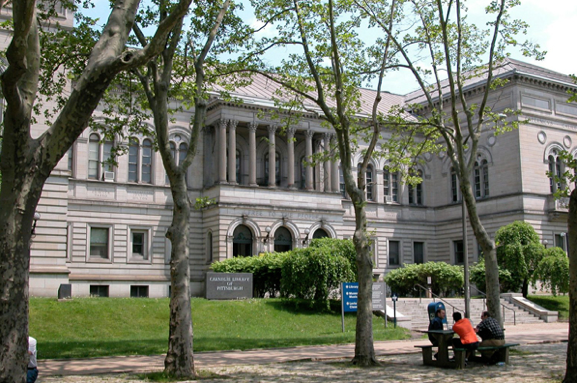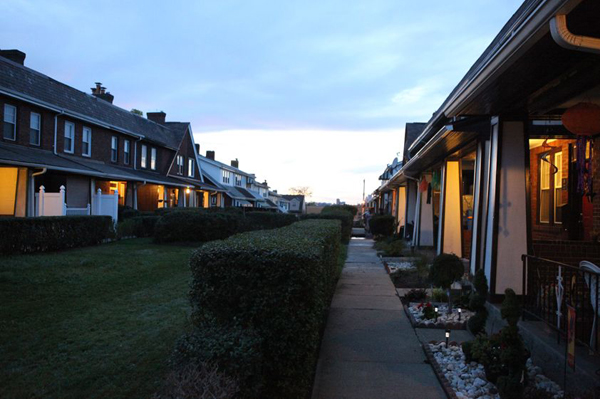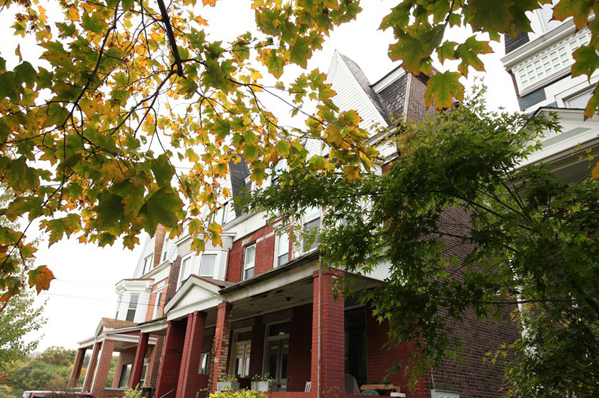One of Pittsburgh's liveliest neighborhoods, Oakland is dense with hospitals, universities, museums, stores and restaurants. If it was a city, it would be the third largest in Pennsylvania. While the area is largely developed, new buildings such as the recently announced gateway hotel and conference center, are still popping up.
Its counterpart in Cleveland, The University Circle neighborhood, has been a hub for universities, hospitals and museums for over a century, and is now alive with construction. The first residents are living in the sleek Uptown community, a $44 million project that replaced a dull, outdated shopping plaza with a town center whose shops and eateries hug the street.
In East Baltimore, the home of Johns Hopkins University’s School of Medicine, more than 1,200 new homes are springing up where doctors once complained of watching drug deals from their office windows. The $1 billion Science and Technology Park project is being developed by a group of private and institutional partners.
These developments all have at least one thing in common – they are being led, planned or paid for by major institutions like universities, hospitals and museums. These stakeholders, often called “anchor institutions” because of their key role in stabilizing neighborhoods, are increasingly not only drivers of job growth and innovation, but also powerful players in remaking cities into vibrant, livable places.
“Cities are back, downtowns are back, and the places that we call anchor districts are leveraging growth in cities,” says Chris Ronayne, President of University Circle Inc. in Cleveland, a nonprofit group that worked with institutions like Case Western Reserve University to bring the Uptown project to fruition. “They’re the places shaping the new metropolis.”
Agreed, says Don Smith of the RIDC who used to head up the Oakland Keystone Industrial Zone. It's been going on in Oakland as the hub for a long time. “The challenge for Oakland is, it's so built up there's not a lot of opportunity,” he says. Yet there's still plenty of momentum from University of Pittsburgh and Carnegie Mellon and UPMC as they spin out startup companies and shape neighborhood development. Now the results of these partnerships are evident in other areas such as Lawrenceville, Hazelwood and East Liberty, he notes.
Looking Outward
A historic shift is occurring as anchors re-engage with communities, Ronayne says. In the not-so-distant past, big institutions like Case Western Reserve University, University Hospitals and the Cleveland Clinic were criticized for being less than responsive to their neighbors. They were accused of building barricades between their campuses and surrounding, poorer neighborhoods by tearing down properties for parking lots.
The story is an old and oft-repeated one – as anchors grappled with urban blight in past decades, they retrenched and retreated inward to the point of excluding their neighbors. The question now becomes – can institutions use their power to connect neighbors to opportunity? Can they give neighbors a voice in planning equitable communities?
“The challenge is how you structure those partnerships with the community and the expectations on both sides,” says Smith. He notes the attitude of “go get these nonprofits” for not paying property taxes which “poisons partnerships,” he says, “rather than try to work collaboratively which is what you see in Cleveland and Baltimore.”
Others cite areas in underserved neighborhoods where the universities are having more of an influence these days: Hazelwood, Homewood and the Uptown corridor, a natural connection between Oakland and downtown. And things are still happening in well-developed Oakland: Just recently, there was an announcement of a major hotel and conference center in the gateway.
Since Eds and Meds led the recovery in Pittsburgh, it seems like we're ahead of the game according to one university official.
In Cleveland, it might be a different story. “Anchor institutions are the engines of a new urban renaissance,” says Ronayne, citing the multi-million dollar investment of University Hospitals in purchasing services from a local, employee-owned laundry, Evergreen Cooperatives, as one example of how mega-institutions can use their clout. It's based locally and run locally and a group in Pittsburgh is looking to replicate it here.
He also cites investment in new housing, retail options and public spaces across the community as examples of how institutions are creating urban vibrancy.
Yet although Eds and Meds are now many cities’ largest employers, including Pittsburgh, having one district is not enough.
In Pittsburgh, look to the SouthSide Works and more recently, Bakery Square for more examples of development influenced by anchor institutions. “Without these institutions none of this would have happened,” says Smith.
Google is here because of Carnegie Mellon, he adds. In Lawrenceville, CMU's National Robotics Engineering Constortium has helped to attract startups in the neighborhood, including the Chocolate Factory on 43rd, he points out.
All about Partnerships
At a recent conference focused on how anchor districts are shaping the new metropolis, district leaders said that the key is creating real partnerships with neighbors. Two-way collaboration with local neighborhood groups is essential to creating a big impact, argued David Angel of Clark University, speaking in Cleveland last October.
“While it may feel like a risky step to take, [creating partnerships] is an enormously rewarding, important step to take in fulfilling the goals of flourishing cities,” he says.
As an example, Angel cites the importance of nonprofit community development groups, which can serve as a conduit between large institutions and surrounding communities. Although Clark University, located in Worcester, Massachusetts, has just one seat on the local CDC’s board of directors, the school believes in accepting community input.
“That’s actually pretty scary for someone like me that is used to managing vertical organizations. It leads to a messy process, but I have to embrace those decisions.”
The big advantage of institutions, Angel says, is that they are able to make 30-50 year commitments that most companies or organizations simply wouldn’t be able to make. Their financial and organizational wherewithal allows them to be patient investors.
“I’m the third university president to take part in these initiatives,” he says. “We’ve leveraged around $135 million within the community within the past few decades.”
Clark University has created a high-performing urban public school and rolled out the Promise Neighborhood Initiative, which allows any child who attends school in the neighborhood for five years and is admitted to Clark University to go for free.
Here in Pittsburgh, UPMC is a major investor in the Pittsburgh Promise, a similar scholarship program for city students who maintain a grade point average of 2.5 and are eligible for $40,000 in college scholarships. It's designed to be an incentive for families to either stay in or move to the city.
Beyond Town vs. Gown
Of course, partnerships sound nice in theory; yet in practice, they require institutions to share decision making. That’s where the “rubber hits the road,” says Sue Mosey of Midtown Detroit Inc., the nonprofit leading revitalization of this community.
“It’s somewhat better today, but there’s an ongoing tension between communities and anchor districts,” she says. “Some anchors are embracing of true partnerships, and for others it’s really a transaction. Those of us who sit on this side” – individuals who work for neighborhood CDC’s – “know when it’s a true partnership versus just a transaction.”
So what does a true partnership look like? How are anchor institutions bridging the “town versus gown” gap between their campuses and surrounding neighborhoods?
It starts with communication – and lots of it. For instance, Johns Hopkins University met with stakeholders and residents around its Homewood campus for more than a year to identify priorities before announcing a targeted, $10 million investment in the area.
“We hired a consultant and produced a 90-page report with lots of recommendations,” says Dennis O’Shea, a spokesperson for Johns Hopkins. “We calculated it would take $60 million, and we’re contributing $10 million. We’re going to try to attract additional investment from other anchor institutions, foundations, government and individuals.”
The goal is to jumpstart investment. “If we help to get things going by building new housing, then developers will see that, see momentum and want to hop on board.”
Still, others argue that communication alone is not enough – residents must have their own strong organizations to ensure that they have a seat at the decision-making table. Otherwise, there’s likelihood that institutions will make choices based on self-interest.
According to Wanda Wilson, Executive Director of Oakland Planning and Development Corporation in Pittsburgh, organizations like UCI which are largely governed by institutions may not fully represent neighborhood interests.
“Our goal is to do community organizing, to make sure the voice of the community is at the table,” says Wilson. Area institutions do not have seats on her group’s board, she adds, and that’s deliberate – although she continues to work closely with anchors.
Institutions must also do more to ensure that economic opportunities reach residents of surrounding neighborhoods, Wilson argues. That’s why her organization recently led creation of the Oakland 2025 Plan, the area’s first community-driven master plan.
“We need to make sure that Oakland continues to be the engine of Pitt’s innovation economy,” she says. “Institutions need to take bold steps to help make that happen. One of our goals is to increase the number of people who live and work in Oakland.”
Untapped Economic Potential
Oftentimes the neighborhoods surrounding anchor districts are full of hidden economic potential, and anchor institutions can help unlock that by making strategic investments.
What’s happening in the Uptown area of Cincinnati right now offers one example. The Uptown Consortium, a community development corporation in this institution-rich neighborhood, worked tirelessly to get the USquare project underway.
“We have 50,000 employees and 50,000 residents; there’s a tremendous market here that’s untapped,” says Beth Robinson, CEO of the Uptown Consortium. “Developers hear the message and they’re coming in. We’re having a development boom now.”
Building off of Uptown’s successful low-income and market-rate housing developments in recent years, that development boom now includes $700 million worth of projects. USquare has attracted national retailers to an area once starved for stores.
If done properly, that benefit can be felt by local residents on the ground, argues Robinson. “We’re working on a partnership with the Urban League of Cincinnati,” she says. “They’re sponsoring a job training class in order to prepare residents for the construction trades and place them in construction jobs around Uptown.”
Angel hears stories like this from cities across the country. “I’m convinced the role of anchor districts in driving growth in cities will be the success story of this millennium.”
LEE CHILCOTE is managing editor of sister publication HiVelocity in Ohio. Send feedback here.





